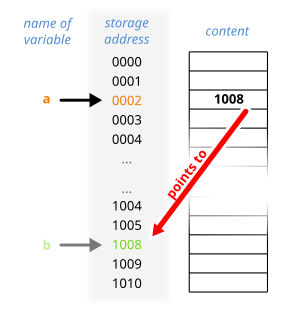In computer science, an array data structure, or simply an array, is a data structure consisting of a collection of elements, each identified by at least one array index or key. An array is stored such that the position of each element can be computed from its index tuple by a mathematical formula. The simplest type of data structure is a linear array, also called one-dimensional array.

C is a general-purpose, procedural computer programming language supporting structured programming, lexical variable scope, and recursion, with a static type system. By design, C provides constructs that map efficiently to typical machine instructions. It has found lasting use in applications previously coded in assembly language. Such applications include operating systems and various application software for computer architectures that range from supercomputers to PLCs and embedded systems.

In computer science, a data structure is a data organization, management, and storage format that enables efficient access and modification. More precisely, a data structure is a collection of data values, the relationships among them, and the functions or operations that can be applied to the data, i.e., it is an algebraic structure about data.
In computer science, a linked list is a linear collection of data elements whose order is not given by their physical placement in memory. Instead, each element points to the next. It is a data structure consisting of a collection of nodes which together represent a sequence. In its most basic form, each node contains: data, and a reference to the next node in the sequence. This structure allows for efficient insertion or removal of elements from any position in the sequence during iteration. More complex variants add additional links, allowing more efficient insertion or removal of nodes at arbitrary positions. A drawback of linked lists is that access time is linear. Faster access, such as random access, is not feasible. Arrays have better cache locality compared to linked lists.
In computer programming, a dope vector is a data structure used to hold information about a data object, especially its memory layout.
In computer programming, the stride of an array is the number of locations in memory between beginnings of successive array elements, measured in bytes or in units of the size of the array's elements. The stride cannot be smaller than the element size but can be larger, indicating extra space between elements.

The syntax of the C programming language is the set of rules governing writing of software in the C language. It is designed to allow for programs that are extremely terse, have a close relationship with the resulting object code, and yet provide relatively high-level data abstraction. C was the first widely successful high-level language for portable operating-system development.

In computer science, a pointer is an object in many programming languages that stores a memory address. This can be that of another value located in computer memory, or in some cases, that of memory-mapped computer hardware. A pointer references a location in memory, and obtaining the value stored at that location is known as dereferencing the pointer. As an analogy, a page number in a book's index could be considered a pointer to the corresponding page; dereferencing such a pointer would be done by flipping to the page with the given page number and reading the text found on that page. The actual format and content of a pointer variable is dependent on the underlying computer architecture.
In computer science, a union is a value that may have any of several representations or formats within the same position in memory; that consists of a variable that may hold such a data structure. Some programming languages support special data types, called union types, to describe such values and variables. In other words, a union type definition will specify which of a number of permitted primitive types may be stored in its instances, e.g., "float or long integer". In contrast with a record, which could be defined to contain a float and an integer; in a union, there is only one value at any given time.
In computing, aliasing describes a situation in which a data location in memory can be accessed through different symbolic names in the program. Thus, modifying the data through one name implicitly modifies the values associated with all aliased names, which may not be expected by the programmer. As a result, aliasing makes it particularly difficult to understand, analyze and optimize programs. Aliasing analysers intend to make and compute useful information for understanding aliasing in programs.
Loop unrolling, also known as loop unwinding, is a loop transformation technique that attempts to optimize a program's execution speed at the expense of its binary size, which is an approach known as space–time tradeoff. The transformation can be undertaken manually by the programmer or by an optimizing compiler. On modern processors, loop unrolling is often counterproductive, as the increased code size can cause more cache misses; cf. Duff's device.
In computing, an uninitialized variable is a variable that is declared but is not set to a definite known value before it is used. It will have some value, but not a predictable one. As such, it is a programming error and a common source of bugs in software.
The computer programming languages C and Pascal have similar times of origin, influences, and purposes. Both were used to design their own compilers early in their lifetimes. The original Pascal definition appeared in 1969 and a first compiler in 1970. The first version of C appeared in 1972.
In the C programming language, data types constitute the semantics and characteristics of storage of data elements. They are expressed in the language syntax in form of declarations for memory locations or variables. Data types also determine the types of operations or methods of processing of data elements.
A class in C++ is a user-defined type or data structure declared with keyword class that has data and functions as its members whose access is governed by the three access specifiers private, protected or public. By default access to members of a C++ class is private. The private members are not accessible outside the class; they can be accessed only through methods of the class. The public members form an interface to the class and are accessible outside the class.
sizeof is a unary operator in the programming languages C and C++. It generates the storage size of an expression or a data type, measured in the number of char-sized units. Consequently, the construct sizeof (char) is guaranteed to be 1. The actual number of bits of type char is specified by the preprocessor macro CHAR_BIT, defined in the standard include file limits.h. On most modern computing platforms this is eight bits. The result of sizeof has an unsigned integer type that is usually denoted by size_t.
In computer programming, a branch table or jump table is a method of transferring program control (branching) to another part of a program using a table of branch or jump instructions. It is a form of multiway branch. The branch table construction is commonly used when programming in assembly language but may also be generated by compilers, especially when implementing optimized switch statements whose values are densely packed together.
PROMELA is a verification modeling language introduced by Gerard J. Holzmann. The language allows for the dynamic creation of concurrent processes to model, for example, distributed systems. In PROMELA models, communication via message channels can be defined to be synchronous, or asynchronous. PROMELA models can be analyzed with the SPIN model checker, to verify that the modeled system produces the desired behavior. An implementation verified with Isabelle/HOL is also available, as part of the Computer Aided Verification of Automata project. Files written in Promela traditionally have a .pml file extension.
In computer science, an array type is a data type that represents a collection of elements, each selected by one or more indices that can be computed at run time during program execution. Such a collection is usually called an array variable, array value, or simply array. By analogy with the mathematical concepts vector and matrix, array types with one and two indices are often called vector type and matrix type, respectively. More generally, a multidimensional array type can be called a tensor type.
The computer programming languages C and Pascal have similar times of origin, influences, and purposes. Both were used to design their own compilers early in their lifetimes.



